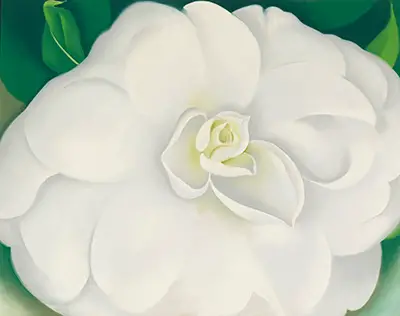This artwork demonstrates her love of nature and expertise with the subtle tonality of the pastel medium. Careful shading of grey, yellow and green enhances the contrast of the white petals and the deep green leaf background enhances the purity of the flower. Most of O'Keeffe's floral works are considered abstract.
This piece exhibits O'Keeffe's impeccable attention to detail and ability to confront the viewer with a magnified still life encapsulation. Each blended stroke refects each petal's softness. It was important to O'Keeffe to create her compositions to evoke the feelings the natural world kindled in her, moreso than the exact depiction of the flower.
Innately feminine, there is also an unconfirmed school of thought that O'Keeffe's careful depiction of flowers could also represent the female vulva. Vehemently denied by O'Keeffe over six decades, this theory was perpetuated by male art critics and is now considered gendered and outdated by some feminists.
Georgia O’Keeffe (1887-1986) was an avant-garde American Modernist artist renowned globally for her bold and detailed floral compositions and southwestern landscapes. Born in Wisconsin, she studied at the Art Institute of Chicago and spent a lot of time visiting New Mexico. Here, she immersed herself in the spirit and traditions of the area and found insipiration in the rugged desert terrain.
After her husband's death in 1946 she moved to New Mexico permanently in 1949 and lived there until her death aged 98.
During the last decade of her life she was hampered by age-related macular degeneration which contributed to her failing eyesight, however, she admirably continued to paint with the help of several assistants.
